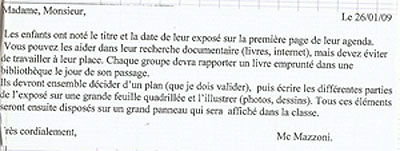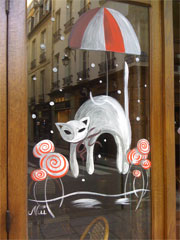The Assignment
A short note pasted in Short-pants‘ Cahier de Correspondence almost escaped my attention. It’s not the first time. I often forget to check. This cahier, not to be confused with her others – the cahier de poésie, cahier du jour, cahier d’essais (the notebook of tries), cahier de leçons – is designated for, as its title suggests, correspondence. It’s where you find school announcements or notes from the teacher. It’s also a vehicle for me to send information to the teacher, for instance to ask if Short-pants can be excused early to go to the dentist. It’s a 6” x 8” inch notebook, with sheets of paper glued on page after page, announcements the teacher handed out to the children, who dutifully took out their glue stick from their pencil cases and pasted them in. I think it’d be a lot easier if we could just e-mail, but this is how it’s done. France, for all its wonders, can be terribly archaic.
The only reason I found out about the note was because one of the other mothers – one who always seems to be totally on top of everything that happens to her son at school – mentioned it to me. For anyone who has (or had) school-aged children, you know the fence or bench or tree or wherever it is that parents congregate to wait for their children to pour out that main door at the end of the day – is akin to the water cooler at the office. Show up a bit early once a week, and you get the scoop on all the school news.

Basically the note says that the children have been given an exposé, or a report, to prepare with two other students. (The topic of this report can be found in another cahier, called, more simply, l’agenda). There are all sorts of rules about how the report must be presented, type of paper, supporting materials, etc. Oh, and the students have to meet together to make a plan, which the teacher wants to approve in advance.
Turning to l’agenda, I discovered Short-pants’ topic: the history of Paris. A fascinating but broad topic to cover in a short report presented by three 7-year olds. I asked her whom she’s been assigned to work with. She didn’t remember.
Let me tell you, I put that cahier de correspondence to hard use last week. Several notes burning back and forth with the teacher enlightened me about the task ahead. Two boys, Lucas and Edgar, share this topic with my daughter. I had to ask the teacher for their phone numbers and I made the calls. To my dismay (no, let’s be honest, it was relief, at least I’m not the only one), they weren’t totally up to speed on the requirements of this exposé either.
The pressure was on, since the winter break loomed and the deep research on this project had to begin. Or at least an outline had to be made. Edgar and his mom couldn’t make a meeting before getting out of dodge for the vacances scolaire. But Lucas and his mom agreed to come over on Saturday last, at least to discuss the project and make a plan for a plan.
Can I tell you how not looking forward to this I was?
My daughter is a self-starter. She does her homework on her own, she volunteers to set the table and other chores that earn her allowance without being asked. She spontaneously initiates spectacular drawing projects or writes a story and pastes the pages together to look like a book. But frankly, this exposé is a bit beyond her capacity. She doesn’t seem to be able to conceptualize it on her own, let alone collaborate with two other kids who are equally unmotivated for the project.

When the doorbell rang, Short-pants ran to greet Lucas (whom she hardly knows, but she was still thrilled to receive him) and his mother and I shook hands cordially. We sat around the table and started to talk about the topic. They’d brought books and DVDs (we hadn’t done anything to prepare, doh!) and Lucas was keen to do something around the Eiffel Tower. Short-pants’ said her favorite building in Paris is Notre Dame. Both moms now had an idea of how we might thread this report together, but should we suggest it? How much should we help? It was clear to me – I think to her as well – that we ought to be facilitative, inspiring the children to conceive the project as well as execute it. But even in this 1½-hour meeting, getting our kids to focus on the topic at hand was a bit like herding cats.
At one point I just cradled my head in my hands and silently cursed the teacher. If the kids were 14-years old, this would be a lot of fun. (Okay, fun? Who am I kidding? But at least it would be more, say, engaging.) I just think this assignment is not age-appropriate (to use an over-used American parenting term). I looked across at Lucas’ mother. “I think this assignment is more for the parents than the kids,” I said. She nodded in full agreement.
We did our best. As the meeting went on, Lucas’ mother and I became more interested in each other, sporadically abandoning the discussion of Parisian history to share a bit of personal information about ourselves. Then we’d turn back to the kids, who’d be playing a game with their fingers, making zero progress during our tangent. We’d try to focus them again. We’d ask questions. How about this? How might you express that? What happened there? I cannot lie: by the end we were pretty much summing it up for them. It was that, or sit around the table all day.
Now we have an outline, a rough draft we will share with the third child (I’m prayin’ there’s no objection). Six of Paris’ monuments have been selected, from different periods of her history. Another meeting after the school vacation will (hopefully) pull it all together – that is, of course, after we get Edgar’s buy-in and the teachers stamp of approval.
After they left, I asked Short-pants how she felt about the meeting. “Great!” she said, her usual response. She’s generally optimistic. “How do you feel?” she asked. I reviewed the morning’s working session in my mind. Lucas was pretty sweet, drawing all the monuments as we discussed them. I really liked his mother, a lot. She seems like a cool lady.
Curse the teacher all I want, a few good things might come of this assignment after all.


February 18th, 2009 at 8:36 pm
Great entry Mags. I wish I’d been as good a mom as you. I was revolted by the whole schoolwork thing, and my kids knew it, and thus we all just had to muddle through with luck and disaster in relatively equal measures.
February 20th, 2009 at 12:54 pm
I’m a bit revolted by it too, but I’m managing it, for now.